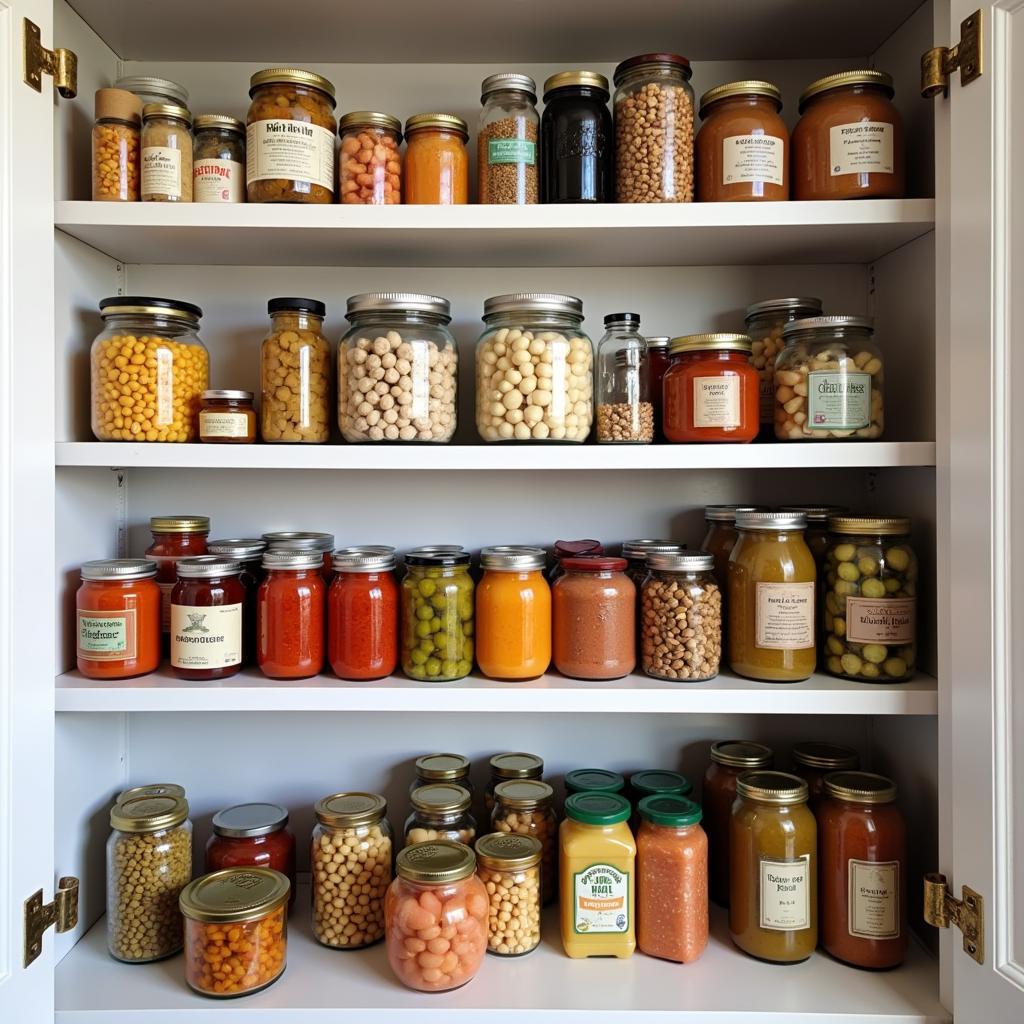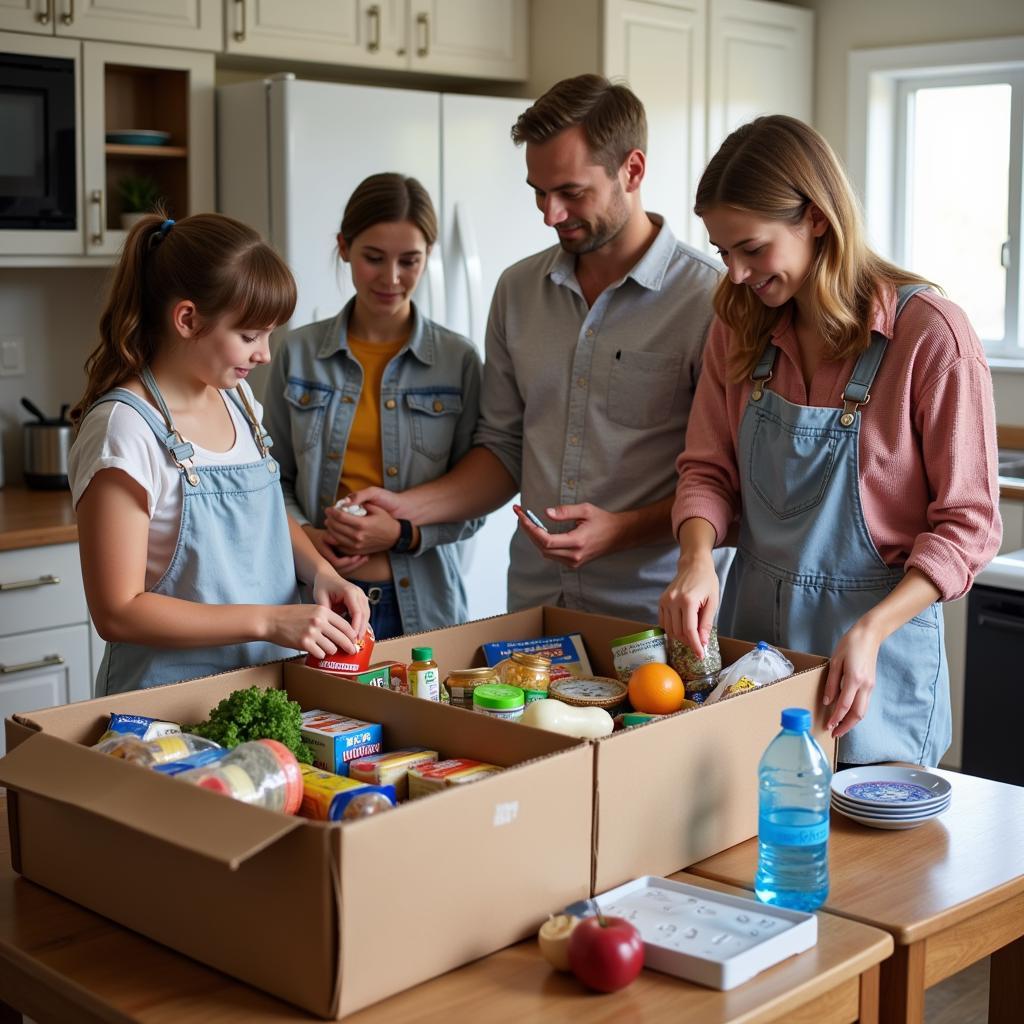In today’s unpredictable world, having an Emergency Food Supply Kit is no longer just a recommendation—it’s a necessity. Whether it’s a natural disaster, power outage, or unexpected job loss, being prepared can make a world of difference. This guide will equip you with the knowledge and resources to build a comprehensive emergency food supply kit that meets your family’s needs, ensuring peace of mind in times of uncertainty.
Understanding the Importance of an Emergency Food Supply
Imagine this: a severe storm hits your area, knocking out power and making roads impassable. Grocery stores are closed, and you have limited access to food and water. This is where your emergency food supply kit becomes your lifeline, providing essential sustenance until normalcy resumes.
A well-stocked kit can help you:
- Survive for an extended period: Aim for at least a three-day supply of food and water per person, but ideally, consider a two-week supply for greater preparedness.
- Maintain health and well-being: Choose nutritious foods that provide essential vitamins and minerals, supporting physical and mental health during stressful times.
- Reduce anxiety and stress: Knowing you have food security can alleviate panic and uncertainty, allowing you to focus on navigating the challenges at hand.
Essential Components of a Well-Rounded Emergency Food Kit
Building an emergency food supply kit doesn’t have to be overwhelming. By focusing on key categories and incorporating a variety of options, you can create a kit that caters to different tastes and dietary needs.
1. Non-Perishable Food Items: The Foundation of Your Kit
Non-perishable foods form the backbone of your emergency food supply. These shelf-stable items require no refrigeration and can last for months or even years, ensuring you have access to calories and nutrients when you need them most.
Here are some reliable options to include:
- Canned goods: Soups, vegetables, fruits, beans, tuna, chicken, and ready-to-eat meals provide essential vitamins, minerals, and protein. Choose low-sodium options when possible.
- Dried fruits and nuts: These nutrient-dense snacks offer energy-boosting carbohydrates, healthy fats, and fiber, making them ideal for on-the-go sustenance.
- Grains and pasta: Rice, quinoa, oats, and pasta are versatile staples that provide carbohydrates for energy. Opt for quick-cooking varieties or consider pre-cooked options for added convenience.
- Protein bars and trail mix: These portable snacks offer a quick source of protein, carbohydrates, and healthy fats, helping to curb hunger and sustain energy levels.
 Emergency Food Pantry
Emergency Food Pantry
2. Water: The Most Critical Element
Water is essential for survival, and having an adequate supply is non-negotiable. Store at least one gallon of water per person per day for drinking and sanitation purposes.
Consider these tips for water storage:
- Use sturdy, BPA-free containers: Purchase food-grade containers specifically designed for water storage. Avoid using milk jugs or other repurposed containers that may leach harmful chemicals.
- Store in a cool, dark place: Heat and light can degrade the quality of stored water. Find a cool, dark location, such as a basement or pantry, to keep your water supply fresh.
- Rotate your water supply: Water doesn’t technically expire, but it’s best to rotate your supply every six months to ensure freshness.
3. Cooking Supplies and Utensils: Essential for Meal Preparation
While having ready-to-eat meals is convenient, having the ability to cook or heat food can significantly enhance your comfort and morale during an emergency.
Include these essential items in your kit:
- Portable stove and fuel: A small camping stove and fuel canisters provide a reliable heat source for cooking meals and boiling water.
- Pots, pans, and utensils: Pack a basic set of pots, pans, utensils, and a can opener to prepare and enjoy your meals.
- Heavy-duty aluminum foil: Foil can be used for cooking, wrapping food, and creating makeshift bowls or plates.
4. Hygiene and Sanitation: Maintaining Cleanliness for Health
Maintaining hygiene is crucial during emergencies to prevent the spread of germs and illnesses.
Pack these essential sanitation items:
- Hand sanitizer: Choose a hand sanitizer with at least 60% alcohol to kill germs when soap and water are unavailable.
- Wet wipes: Wet wipes are versatile for cleaning hands, surfaces, and even bodies when showering isn’t an option.
- Trash bags: Keep your environment clean and sanitary by packing trash bags for proper waste disposal.
Customizing Your Emergency Food Supply Kit
While the essential components mentioned above provide a solid foundation, it’s important to customize your kit based on your family’s specific needs and preferences.
Consider these factors:
- Dietary restrictions and allergies: Ensure your kit includes foods that meet everyone’s dietary needs, whether it’s gluten-free, dairy-free, vegetarian, or other specific requirements.
- Medications and special formulas: If you or a family member relies on specific medications or infant formulas, include an ample supply in your kit.
- Comfort foods and snacks: Include a few comfort foods and snacks to boost morale and provide a sense of normalcy during stressful times.
 Family Preparing Emergency Kit
Family Preparing Emergency Kit
Maintaining and Rotating Your Emergency Food Supply
Once you’ve assembled your emergency food supply kit, it’s crucial to maintain it properly to ensure its freshness and effectiveness when you need it most.
Follow these essential maintenance tips:
- Store in a cool, dry place: Extreme temperatures and humidity can degrade the quality of food. Choose a cool, dry location, such as a basement, pantry, or closet, to store your kit.
- Check expiration dates regularly: Make it a habit to check expiration dates every few months and replace any expired items promptly.
- Rotate your food supply: Use the “first in, first out” method, rotating older items to the front and using them before they expire.
Beyond the Basics: Additional Considerations
While food, water, and hygiene supplies are paramount, consider these additional items to enhance your kit’s functionality and comfort:
- First-aid kit: A well-stocked first-aid kit is essential for addressing minor injuries and ailments.
- Emergency radio: A hand-crank or battery-powered radio will keep you informed about weather updates and emergency instructions.
- Whistle and signaling devices: A whistle can help you signal for help if you become lost or stranded.
- Cash and copies of important documents: Keep a small amount of cash on hand and store copies of important documents, such as identification and insurance information, in a waterproof bag.
Conclusion
Building an emergency food supply kit is an investment in your family’s safety and well-being. By following the guidelines outlined in this guide, you can create a comprehensive kit that provides peace of mind, knowing you’re prepared for whatever challenges may arise. Remember to customize your kit to meet your family’s specific needs, rotate your supplies regularly, and consider additional items that enhance your preparedness. With a little effort, you can face the unexpected with confidence, knowing you have the resources to weather any storm.
Frequently Asked Questions About Emergency Food Supply Kits
1. How much food should I store in my emergency kit?
Aim for at least a three-day supply of food per person, but ideally, consider a two-week supply for greater preparedness.
2. What are the best types of food to store for emergencies?
Choose non-perishable foods that require no refrigeration, such as canned goods, dried fruits, nuts, grains, and protein bars.
3. How should I store my emergency food supply?
Store your kit in a cool, dry place, away from direct sunlight and extreme temperatures.
4. How often should I rotate my emergency food supply?
Check expiration dates regularly and rotate your food supply every six months to ensure freshness.
5. What else should I include in my emergency kit besides food?
Consider adding a first-aid kit, emergency radio, whistle, cash, and copies of important documents.
Need help putting together your perfect 5-gallon bucket of food? Or looking for organic survival food options? Perhaps you’re considering dehydrated food emergency supplies or need reliable food preservation bags? We’ve got you covered!
Contact our 24/7 customer support team at 02437655121 or minacones@gmail.com. You can also visit us at 3PGH+8R9, ĐT70A, thôn Trung, Bắc Từ Liêm, Hà Nội, Việt Nam. Let us help you prepare for a safer tomorrow!